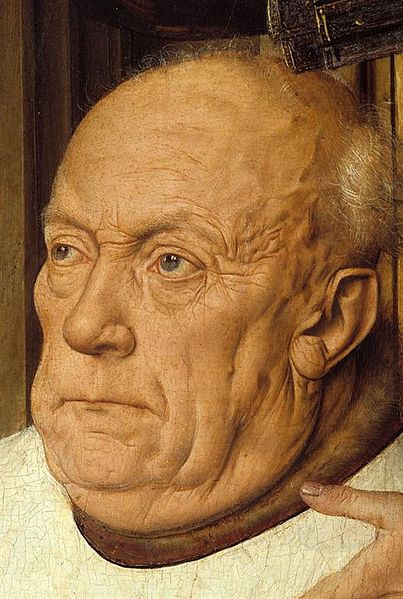Virgin and Child with Canon van der Paele
The Virgin and Child with Canon van der Paele is a large oil-on-oak panel painting completed around 1434–1436 by the Early Netherlandish painter Jan van Eyck. It shows the painting's donor, Joris van der Paele, within an apparition of saints. The Virgin Mary is enthroned at the centre of the semicircular space, which most likely represents a church interior, with the Christ Child on her lap. St. Donatian stands to her right, Saint George—the donor's name saint—to her left. The panel was commissioned by van der Paele as an altarpiece. He was then a wealthy clergyman from Bruges, but elderly and gravely ill, and intended the work as his memorial.
The Virgin and Child with Canon van der Paele, 1434–1436. Oil on wood, 141 x 176.5 cm (including frame), 122 x 157 cm (excluding frame). Groeningemuseum, Bruges.
Canon van der Paele
Detail of Van der Paele's prayer book and spectacles
Madonna of Chancellor Rolin, around 1435, Musée du Louvre. Like van der Paele's panel, this work was created as an eventual memorial for the donor's burial church, in this case for Nicolas Rolin's family chapel in Notre Dame-du-Chastel in Autun.
Jan van Eyck was a Flemish painter active in Bruges who was one of the early innovators of what became known as Early Netherlandish painting, and one of the most significant representatives of Early Northern Renaissance art. According to Vasari and other art historians including Ernst Gombrich, he invented oil painting, though most now regard that claim as an oversimplification.
Portrait of a Man (Self Portrait?) by Jan van Eyck, 1433. National Gallery, London
The Arnolfini Portrait, oil on oak, 1434. National Gallery, London
Hubert and Jan van Eyck, Ghent Altarpiece, completed 1432. Saint Bavo Cathedral, Ghent
Portrait of Margaret van Eyck, Groeningemuseum, Bruges, 1439








